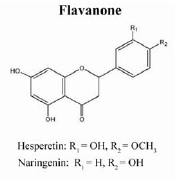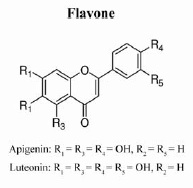A Case for the Paleolithic Diet
|
Dear Friends, 
We want the whole package that mother nature can give us. Not just the vitamins, minerals, carbs, proteins, fats and fibers, extracted out and remixed into some highly processed concoction that we have come to call food. We need a broad range of flavonoids to protect our health. Good, bad or otherwise, nature does not put all 6,000 of them in every single fruit and vegetable; so we must eat off the color wheel—eat paleolithic. A good supplementary program brings in a wide variety of phytochemicals. We’ve been focusing on the flavonoids and we continue this week with two more—the flavones and the flavanones.
The white fleshy pulp on the innersurface of the citrus skin and the membranes that separate the segments have a high flavanone content. Only a small amount is transfered to the juice during processing (hence drink fresh squeezed juice). The consumption of citrus fruit has been associated with lower risk of acute coronary events and strokes (Brassi et al 2009). The major flavonoid in oranges, hesperidin, was evaluated in overweight men. Four weeks consuming 500ml of orange juice per day resulted in a decrease in the diastolic BP as well as postprandial increases of endothelium-dependent microvascular reactivity and cardiovascular risk biomarkers (Morand et al 2011). Remember last week we talked about Vitamin P as an old label given to the group of bioflavonoids that protect against acute permeability conditions within the vascular system—an extreme example would be a conditions like scurvy. Hesperidin is a major player on this anti-permeability team, as is Vitamin C. They seem to work together. Vitamin C functioning as an antioxidant and hesperidin rebutting Vitamin C back to it antioxidant state. In Europe, hesperidin is used to treat venous insufficiency and hemorrhoids. It is helpful in reducing capillary peremeability. Researchers in Italy have shown that hesperitin reduces inflammation, lowers hypertension and increases HDL and lowers LDL. In a series of animal and human experiments at the University of Western Ontario by Dr. Kurowska hesperitin was found to restrict the liver’s production of cholesterol esters, which are a major constituent in LDLs, without which they cannot be formed. This is only the tip of the iceberg regarding the health benefits of hesperidin and other phytochemicals within oranges. Reseachers have found that hesperidin slowed the replication of several viruses including polio, herpes and flu. It may also treat cancer and some autoimmune diseases. Another phytochemical within oranges, the limonoids, which are in the terpenoid subgroup (not a flavonoid) are 45 times more effective in blocking tumor formation than hesperitin. Consider the fact that University of Western Ontario researchers found hesperidin more effective at slowing the proliferation of breast cancer cells than genistein—the highly touted cancer fighting compound in soy (Joseph, The Color Code 2002). We will cover limonoids in a couple weeks when we look at the Terpenes.
In recent years, scientific and public interest in flavones has grown enormously due to their beneficial effects against atheroscherosis, osteoporosis, diabetes mellitis, autoimmune disease and cancers. I’ll focus in brief on the last two—autoimmune disease and cancer. Autoimmune Disease In Richard Verbeek’s and fellow researchers study, the inhibiting effects of various flavonoids on antigen-specific proliferation and interferon-gamma production by human and murine autoreactive T cells, were evaluated in vitro. T-cell responses were evaluated for the human autoantigen alpha B-crystaqllin, a candidate autoantigen in multiple sclerosis, and for the murine encephalitogen proteolipid protein peptide. The flavones apigenin and luteolin were found to be strong inhibitors of both murine and human T-cell responses, while fisitin, quercetin, morin and hesperitin, members of flavonols and flavanones were ineffective. (Verbeek, R. et al, Biochemical Pharmacology 2004) Anti-Oxidant, Anti-Inflammatory and Anti-Allergic Activities of Luteolin (Seelinger, G et al, Planta Med 2008) It [luteolin] displays excellent radical scavenging and cytoprotective properties, especially when tested in complex biological systems where it can interact with other anti-oxidants like vitamins. Seelinger further explains that luteolin operates as an anti-oxidant at micromolar concentrations, but it also does much more. It also works on an epi-genetic level, activating anti-oxidant enzymes and suppressing NFkB pathways. He maintains that luteolin has great potential to protect from diseases associated with inflammatory processes. Cancer Previous studies have indicated that flavonoids exhibit antiproliferative properties on some hormone-dependent cancer cell lines, such as breast and prostate cancer … among the flavonoids tested, apigenin and luteolin are the most potent inhibitors… the present study suggests that flavonoids may prepresent a new class of therapeutic agents in the management of thyroid cancer. (Vin, F. et al, Growth Inhibitory Effects of Flavonoids in Human Thyroid Cancer Cell lines, Thyroid 2009) A study to assess the antioxidant potencies of several dietary flavonoids showed that only apigenin, rutin and quercetin were more potent than Vitamin C in reducing DNA oxidative damage. (Notoozi, M et al, American Journal of Clinical Nutrition 1998) The Dietary Flavones Apigenin and Luteolin Impair Smooth Musclee Cell Migration and VEGF Expression through Inhibition of PDGF Phosphorylation. (Lamy, S et al, Cancer Prevention Research 2006). Platelet-derived growth factor (PDGF) … plays a central role in the maturation and stablization of newly formed vasculature during angiogenensis … [Lamy et al] shows that the dietary flavones apigenin and luteolin may interfere with this event through their inhibitory effect on PDGF…these results identify apigenin and luteolin as dietary-derived chemopreventative proventative molecules. In closing, structural variations in each of the flavonoids leads to wide differences in their observed therapeutic effectiveness; and, makes the case for constructing a diet that brings in a wide variety of fruits and vegatables. It is, of course, argued that the low incidence of cardiovascular disease and cancer in the Mediteranean population correlates with a high intake of flavonoid rich foods. I concur. Let’s bring more flavonoids into our diet. Next week we will finish up the flavonoids by looking at the isoflavones. Sincerely yours, Seann Bardell Clinical Note: We teach the power of food to heal and implement the tradition of food as medicine. That’s what BioImmersion Inc. and the Therapeutic Foods Line are all about. One of many possible examples of implementing the Therapeutic Foods Platform would be to drink a large glass of water with a tablespoon of the Beta Glucan Synbiotic Formual and a teaspoon of the Number 7 Systemic Booster. Right there you have quite a collection of colors and phytochemicals coming in—beets, pomegranate, cranberry, pineapple, tart cherry, not to forget the fiber, vitamins, probiotic organisms (12 different strains) and so on. You could use this drink to chase down a couple tablets of Organic Chlorella, Wild Blueberry Daily, and Cruciferous Sprouts. Now you’ve added the powerful greens and deep dark blues big time. Try it.
This beauty is a Caraval. It is a cross between a male Caracal and a female Serval. These are bread for the pet market. A pure caracal weighs 35-50 pounds. It is the largest of the African lesser cats (the greater being lions, cheetah, etc). The caracal is an exceptional climber and jumper. It hunts by night seeking small animals—birds of all sizes and the young of larger grazing animals. The Serval weighs 30-40 pounds. They hunt by night for rodents, reptiles, birds and small deer. Remember the Duiker antelope from the January 5th Forward Thinking? It’s unbelieveable, an antelope the size of a jackrabbit, and food for these cats. Life is amazing, isn’t it! How would you like to have a 40 pound caraval as a pet? I would!!!
|
 Flavanones are found in large amounts in citrus fruits—naringenin is the most abundant citrus-derived flavanone. The main aglycones are naringenin in grapefruits, hesperetin in oranges, and eriodictyol in lemons.
Flavanones are found in large amounts in citrus fruits—naringenin is the most abundant citrus-derived flavanone. The main aglycones are naringenin in grapefruits, hesperetin in oranges, and eriodictyol in lemons. Flavones are less frequent than the flavonols from last week (ie quercetin) in fruits and vegetables. The most common flavones are luteolin, apigenin and chryslin and their respective glycosides. They are found in broccoli, celery, cherries, tea, olives, thyme, parsley and some herbs. There is some very exciting research regarding their health benefits.
Flavones are less frequent than the flavonols from last week (ie quercetin) in fruits and vegetables. The most common flavones are luteolin, apigenin and chryslin and their respective glycosides. They are found in broccoli, celery, cherries, tea, olives, thyme, parsley and some herbs. There is some very exciting research regarding their health benefits. The Last Quiz Answer:
The Last Quiz Answer:
